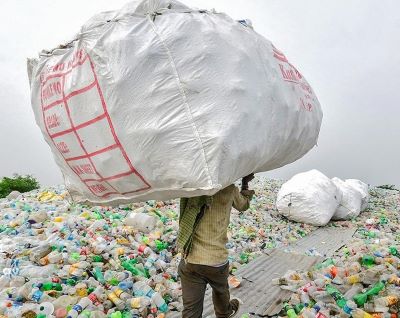Context
Plastic pollution has become a pervasive issue worldwide, infiltrating even the most remote and pristine environments, including the Himalayan mountain range. From the towering peaks to the depths of the ocean trenches, plastic waste has become a ubiquitous presence, posing serious threats to the fragile ecosystems of the region. This article delves into the alarming situation of plastic pollution in the Himalayan states, highlighting its detrimental effects on the environment, wildlife, and human health. It explores the root causes of this crisis, including rapid urbanization, changing consumption patterns, and the surge in tourism. Moreover, it examines the inadequacy of waste management systems in tackling the escalating volumes of plastic waste, along with the legal frameworks in place and the initiatives undertaken by various states to address the issue.
Plastic Pollution in the Himalayan States: A Growing Crisis
The Himalayan region, renowned for its majestic landscapes and rich biodiversity, is now grappling with a mounting crisis of plastic pollution. Microplastics, resulting from the degradation of larger plastic debris, have infiltrated the mountains, rivers, lakes, and streams, posing significant threats to the delicate ecosystems. The Indian Himalayan Region (IHR), serving as a vital source of freshwater for the subcontinent, sustains major river systems like the Ganges, Indus, and Brahmaputra. However, unscientific disposal of plastic waste is leading to soil and water contamination, jeopardizing the region's biodiversity and endangering the freshwater sources crucial for downstream communities.
The surge in urbanization, coupled with shifting production and consumption patterns, has exacerbated the problem of plastic waste in the Himalayan states. The influx of tourists has further compounded the issue, overwhelming existing waste management infrastructure and leading to widespread littering of plastic waste. A recent report by the Social Development for Communities Foundation underscores the severity of the situation, with towns in Uttarakhand drowning in plastic waste. This crisis extends beyond Uttarakhand, with other Himalayan states facing similar challenges. The National Green Tribunal has taken notice of waste dumping in eco-sensitive areas, signaling the urgent need for intervention to mitigate the adverse impacts of plastic pollution.
Challenges in Plastic Waste Management
Despite the enactment of regulatory frameworks such as the Solid Waste Management Rules (SWM) 2016 and Plastic Waste Management (PWM) Rules 2016, the Himalayan states continue to grapple with the challenge of managing plastic waste effectively. The Extended Producer Responsibility (EPR) 2022 mandates producers, importers, and brand owners to take responsibility for the end-of-life disposal of their products, yet implementation remains inadequate, particularly in the hilly terrain. While some states have enacted laws to curb plastic use, the lack of proper infrastructure hampers enforcement efforts. Himachal Pradesh and Sikkim have implemented bans on certain plastic products, but littering persists due to inadequate waste management systems.
Waste segregation at the source is crucial for effective plastic waste management, yet implementation remains deficient, with landfills overflowing with mixed waste. The absence of collaboration between local bodies and producers further complicates the situation. Despite the pivotal role of local bodies in waste management, devolution of power to them is incomplete, hindering effective governance. Moreover, traditional institutions, prevalent in many Himalayan states, are often excluded from waste management initiatives, undermining their potential contributions to the solution. Plugging data gaps and enhancing resource allocation are imperative to address the specific challenges of waste management in the mountainous region effectively.
Legal Mandates and Initiatives
The regulatory frameworks governing plastic waste management, including SWM, PWM, and EPR, provide a foundation for addressing the plastic pollution crisis in the Himalayan states. However, these mandates often fail to account for the unique geographical challenges of mountainous regions. While states like Himachal Pradesh and Sikkim have implemented special laws and bans on plastic use, the efficacy of these measures is limited by the lack of infrastructure and enforcement mechanisms. Mizoram and Tripura have also taken regulatory steps, but tangible results are yet to be seen on the ground.
Efforts to combat plastic pollution require concerted action at the national and state levels, with a focus on empowering local bodies and enhancing waste management infrastructure. The inclusion of traditional institutions in waste management initiatives could leverage local knowledge and resources to address the plastic waste crisis effectively. Moreover, convergence of existing schemes and initiatives, such as the Swachh Bharat Mission and the Finance Commission's grants, could augment resources for waste management in the Himalayan states. Collaboration between local bodies and producers is essential to ensure the success of plastic waste management efforts, with a focus on waste segregation and public participation.
Conclusion
Plastic pollution poses a grave threat to the Himalayan states, endangering their pristine ecosystems and freshwater sources. The indiscriminate disposal of plastic waste, fueled by rapid urbanization and tourism, has overwhelmed existing waste management systems, exacerbating environmental degradation. Despite regulatory frameworks and initiatives, the challenges of plastic waste management persist, necessitating urgent action at the national, state, and local levels. Empowering local bodies, plugging data gaps, and enhancing collaboration between stakeholders are essential steps to address the plastic pollution crisis effectively. By prioritizing sustainable waste management practices and harnessing local resources, the Himalayan states can mitigate the adverse impacts of plastic pollution and safeguard their fragile ecosystems for future generations.
|
Probable Questions for UPSC Mains Exam
|
Source – The Hindu







